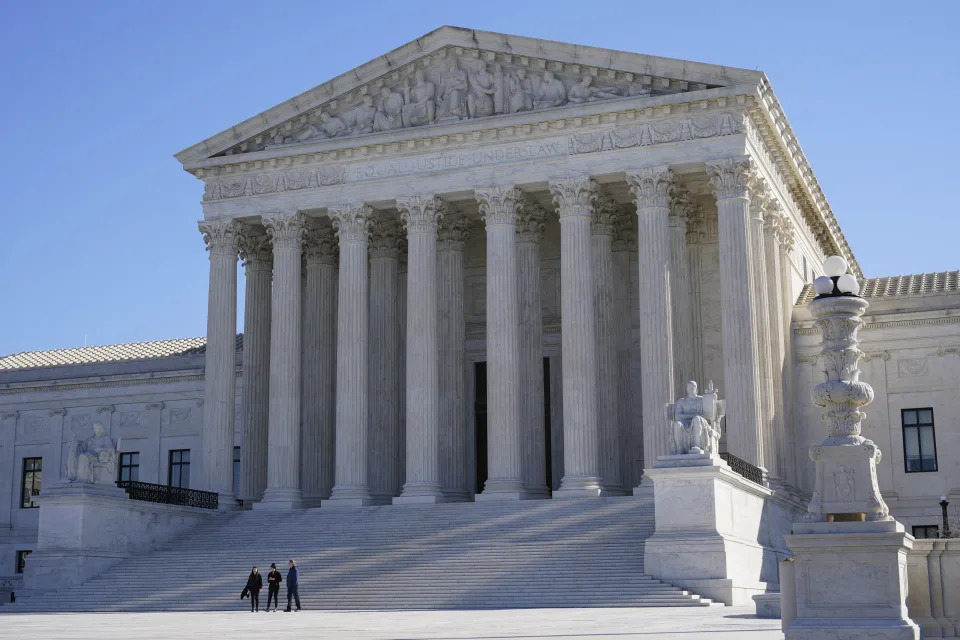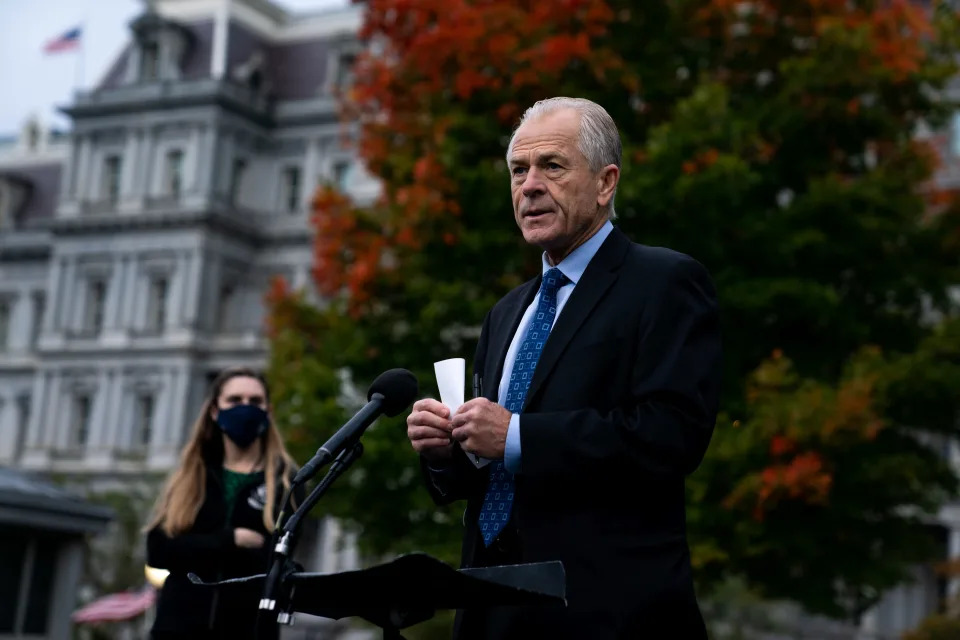NBC News
The Trump Organization used to borrow from major banks. Now look who’s lending it money.
Gretchen Morgenson – April 7, 2022
Donald Trump used to bank with the big guns. Now he’s borrowing from Axos Financial, an obscure, internet-only institution based in San Diego and Las Vegas.
In mid-February, Axos refinanced a $100 million Trump Tower mortgage due in September, a New York City Finance Department document shows. The new loan was made just days after The Trump Organization’s auditor resigned, saying that 10 years of the company’s financial statements could not be relied upon.
In lending to The Trump Organization, Axos is stepping up when other banks have balked. But this is not unheard-of for Axos. An examination of legal filings, internal documents and land records shows Axos has a history of handling atypical loans.
Axos has teamed up with nonbank lenders on loans to small businesses that carried cripplingly high double- and triple-digit effective annual interest rates, loan documents show. The bank has also specialized in loans to foreign nationals, internal documents and its website state, and has offered a type of loan that allows borrowers who paid cash for a property to turn around and instantly take money out. Such loans may pose money laundering risks, banking analysts say.

The bank has also been sued by two former employees who say they were wrongfully fired after they raised questions about its practices. On March 21, Jennifer Brear Brinker, hired in 2018 to review the bank’s loan portfolios for its Governance, Risk Management and Compliance Department, filed suit against Axos in federal court in California.
Brinker accused the bank of intentionally understaffing its compliance department “in an effort to conceal its failure to comply with federal banking regulations” and contends she was terminated in January 2021 while completing a report highlighting deficiencies at Axos including “significant issues in the bank’s anti-money laundering practices.”
A spokesman for Axos, who asked not to be identified, said the bank disputes Brinker’s allegations “and her perception of the underlying factual circumstances.” Axos intends to defend against the lawsuit vigorously, the spokesman added.
A lawyer representing Brinker declined to comment further on her case but said they both look forward to proving her claims in court.
Later this month, Axos is scheduled to face a former internal auditor in a wrongful termination case in California federal court. That auditor, Charles Matthew Erhart, 35, was fired by Axos after he raised concerns about its practices, his 2015 lawsuit says. Among other practices alleged by Erhart — Axos allegedly failed to advise regulators of substantial and risky loans to dubious borrowers, did not disclose to regulators that it had received grand jury and other subpoenas, improperly denied that it held documents responsive to a Securities and Exchange Commission subpoena and instructed employees not to communicate with regulatory officials.
The bank’s spokesman said it denies every one of Erhart’s allegations. “All were investigated, both internally by Axos’s audit committee and independent counsel, and externally by government regulators and outside auditors,” the statement said. “None of the investigations or audits found any merit in Erhart’s allegations.”
‘Cash-recapture loans’
Axos was founded in 2000 as Bank of Internet USA, or BofI, a digital enterprise with no brick-and-mortar branches; it changed its name to Axos in 2018. Its shares trade on the New York Stock Exchange.
With $15.5 billion in assets at the end of 2021, Axos is a relatively small, federally chartered savings institution. J.P. Morgan Chase, by comparison, holds over $3 trillion in assets. Some $12.6 billion of Axos’ assets are loans, including residential mortgages and loans on commercial real estate and multi-family dwellings, SEC filings show.
Axos is overseen by Gregory Garrabrants, a lawyer, former Goldman Sachs banker and McKinsey & Co. consultant. Before joining Axos in October 2007, Garrabrants was an executive at Indymac, a huge California savings & loan that collapsed in July 2008 under a mountain of toxic mortgages, according to bank regulators. Indymac was one of the nation’s biggest bank failures, costing the FDIC fund more than $10 billion, a government investigator estimated.
Axos has been a fast grower and has turned in a torrid stock performance in recent years. In 2018, Garrabrants earned $27 million, just 10 percent less than the $30 million received by Jamie Dimon, the chief executive of JPMorgan Chase.
In lending to the Trump Organization, Axos is forging ties with a borrower that has proved troublesome for other banks over the years, with multiple bankruptcies more than a decade ago and many lawsuits.
Axos declined to comment about the terms of the loan and the Trump Organization’s spokeswoman did not respond to an email seeking comment from NBC News. But Eric Trump told CNN in a statement that “Trump Tower is one of the most iconic properties in the world and sits on arguably the most prestigious corner in all of New York. We have incredibly low debt, have a tremendous amount of cash and have an extremely profitable company. We had no problem refinancing.”
In September, Forbes valued the commercial office and retail space backing the $100 million Trump Tower mortgage Axos refinanced at $285 million; Gucci is a retail tenant on the ground floor, paying an estimated $24 million a year.

The $100 million Trump Tower mortgage represents a large loan for a bank the size of Axos. As a savings association, Axos is subject to limits on loans to one borrower based on a measure of its capital. On June 30, 2021, that limit was $203.8 million, the bank’s filings show, and its largest outstanding loan balance was $145 million.
For fiscal year 2021, Axos held $3.2 billion in commercial real estate loans, or 27.5 percent of its total loans. Most were on properties in California, its regulatory filings show. The new Trump Tower financing increases Axos’ lending in New York state by almost 30 percent, based on its December 2021 holdings.
Axos held $4.4 billion in single-family mortgages in 2021 or 38 percent of its loans held for investment.
In her lawsuit, former employee Brinker alleged that in 2020 Axos tried to conceal problems with home loans made to borrowers by A & D Mortgage, a Hollywood, Fla.-based nonbank mortgage lender financed by Axos. The bank failed to tell its board or its investors the loans had become problems, Brinker alleged. A&D Mortgage was funded by an Axos credit line for five years, from April 2016 to April 2021, Uniform Commercial Code filings show.
A&D would sell the mortgages it had underwritten using Axos’s line of credit into a pool of loans packaged and issued by a related entity known as Imperial Fund Capital Partners. But when Covid struck, investors refused to buy the security and the loans remained as collateral backing Axos’s credit line for longer than the 60 days the bank’s policy allowed, according to Brinker’s lawsuit.
A&D Mortgage is headed by Maksim Slyusarchuk, according to Florida corporate records, who described himself in a 2013 lawsuit he filed in Miami-Dade County as “an international businessman with experience in the Russian markets and in international finance.”
Slyusarchuk also owns 50 percent of Imperial Fund Capital, an SEC registered investment adviser with $316 million under management; it pools mortgages into securities and sells them to investors. One of its units, Imperial Fund II LLC, is financed by Sovcombank, a UCC filing shows, Russia’s ninth largest bank. Sovcombank was sanctioned by the U.S. Treasury on Feb. 24.
Neither A&D Mortgage, Imperial Fund nor Slyusarchuk responded to an email message seeking comment.
On its website, Axos says it has extensive experience in mortgage lending to “nonresident aliens” and offers loans of up to $20 million accompanied by 50 percent down payments. A 2014 investor presentation noted that the bank specialized in lending to Chinese nationals, for example, who do not have tax returns that they can present to document their financial standing.
Axos has also made loans to Russian nationals; asked about the risk of such lending given the Ukraine invasion, the Axos spokesman said they represent a fraction of 1 percent of Axos’ loans. “All such loans were done at low loan-to-value ratios and are well secured,” he added.
The 2014 Axos investor presentation also shows the bank offered so-called cash recapture loans, made to individuals paying cash in full for a property who want “to recoup some of their investment.” The bank required no waiting period to cash out, the presentation noted, but said the source of the initial purchase funds “must be sourced/seasoned.” Bank analysts say such loans may raise the risk of money laundering.
The Axos spokesman said the bank conducts “a full, know-your-customer investigation” of each cash-recapture loan applicant. The loans are “subject to strict underwriting and program qualification parameters,” he said, “designed to ensure full compliance with Anti-Money Laundering and Bank Secrecy Act laws and all other legal or regulatory requirements.”
Axos has also teamed up with some aggressive non-bank lenders charging sky-high interest rates to small business borrowers, NBC News has previously reported. The bank conducted some of these arrangements through its unit in Nevada, a state with no interest rate limits, allowing downstream lenders to evade state usury caps on loans they made to borrowers operating in more restrictive jurisdictions. Predatory lending experts call these arrangements “rent-a-bank schemes,” and they were permitted under a Trump-era banking rule. Last year, President Joe Biden signed a resolution rescinding the rule.
Axos disputed that this business involved “rent-a-banks” and said its operation was “a bank sponsorship program, operated so as to be fully compliant with legal and regulatory requirements, through which it entered into agreements with several third-party service providers.” All but one of these programs have been wound down, the spokesman added.
Joint interest agreement
In recent years, Axos has aggressively pursued anonymous bloggers who posted critical analyses of the bank’s activities on investing websites, court documents show. In 2017, Axos joined forces with top executives at MiMedx Group, a formerly high-flying maker of skin grafts, to identify anonymous critics of the companies. Axos and MiMedx entered into a “joint interest agreement” to investigate the critics, court documents and internal emails show.
Two of the top MiMedx executives with whom Axos pursued the joint interest agreement — former chief executive Parker Petit and former COO William Taylor — were convicted of fraud in 2021 and sentenced to jail in a case unrelated to Axos. Much of what had been alleged about MiMedx by the critics it targeted turned out to be accurate, the criminal case showed.
A spokeswoman for MiMedx said the company does not comment on legal matters but noted that its “senior leadership team and board of directors are entirely new since 2019.”
Regarding its arrangement with the convicted former MiMedx executives, the Axos spokesman said that when it struck the agreement with Petit and Taylor, Axos needed to communicate with MiMedx about the activities of investors who had bet against both companies and publicized those bets. He added that “the truth of allegations against MiMedx was unknown and the company and its executives appeared to enjoy a favorable reputation.”
The Erhart case
Later this month, the 2015 wrongful termination case filed by Erhart, the former Axos auditor, is scheduled to go to trial. Erhart‘s lawyer, Carol Gillam, declined to comment on the case.
Erhart began working at Bank of Internet, as Axos was known at the time, in Sept. 2013, documents show. Previously an examiner at the Financial Industry Regulatory Authority, he’d led an examination that identified a broker who allegedly stole $4.2 million from his customers, his lawyer said.
A native of rural Kansas who put himself through the University of Kansas working on an assembly line and a road construction crew, Erhart began identifying problems soon after he was hired at Axos, according to his complaint. He says he expressed concerns about concentration risk at the bank, for example, noting to superiors that just nine of its customers accounted for 40 percent of its total deposits. Erhart alleges that he was advised by his boss’s superior not to put that information in an email.
Some of Erhart’s allegations about Axos’s practices had to do with the Bank Secrecy Act, which aims to curtail and detect money laundering and loans to what banking regulators call “politically exposed persons.” They are people who, because of their public positions or relationships, “may present a risk higher than other customers by having access to funds that may be the proceeds of corruption or other illicit activity.”
Banks are supposed to collect information about customers’ risk profiles to monitor and determine whether a client’s banking activities are suspicious. Erhart contended in his lawsuit the bank made material alterations of “numerous reports” required under the Bank Secrecy Act’s quality control rules and did not disclose substantial loans to criminals and politically exposed persons. In early 2015, Erhart’s complaint says, he uncovered information about borrowers who exposed the bank to reputation risk, including “very high level foreign officials from major oil-producing countries and war zones.” He did not identify specific borrowers in the complaint.
In March 2015, Erhart turned over bank records to Axos’s main regulator, the Treasury Department’s Office of the Comptroller of the Currency, his complaint said. He emailed the information he had compiled to his mother for safekeeping. He was fired in June 2015.
The OCC has not taken regulatory action against the bank. Erhart now works as a partner at a cryptocurrency consulting firm.
“In the years since Erhart first made his allegations,” the bank’s spokesman said, “Axos has suffered no adverse business event, no restatement, no spike in reserves, no loss of a major contract, no material weakness disclosure, no earnings miss. Independent auditors and government regulators — all with full knowledge of all Erhart’s allegations — have consistently issued clean audit opinions, passed examinations, and granted further regulatory approvals for more than seven full years.”
Asked to supply copies of the clean audit opinions and examinations, Axos declined, saying they are confidential.
The company did supply a copy of a 2017 letter from the Securities and Exchange Commission saying it had closed an investigation into Axos and did not intend to recommend an enforcement action against the bank. Still, the SEC said its letter “must in no way be construed as indicating that the party has been exonerated or that no action may ultimately result from the staff’s investigation.”
In a separate civil case in 2017, Garrabrants sued Erhart alleging that he had stolen his confidential information. The bank also sued Erhart’s mother in Kansas, to whom the former auditor had sent information about the bank’s activities for backup. Axos settled the case against Erhart’s mother; it declined to state the terms.
Garrabrants’ case against Erhart went to trial last fall. The jury found that Erhart had violated California law “in connection with theft of Garrabrants’ personal, confidential, and financial information,” the bank’s spokesman said.
Gillam, Erhart’s lawyer, provided a statement on this suit. “The documents Mr. Erhart accessed that related to Mr. Garrabrants were in bank files he found in the course of doing his work as an internal auditor,” she said. “They were only used to support Mr. Erhart’s allegations of wrongdoing that he presented to the bank’s principal regulator, the Office of the Comptroller of the Currency.”
The jury “rejected Garrabrants’ claim of intentional infliction of emotional distress and awarded him $1,500 on an invasion of privacy claim,” Gillam added. On an anti-hacking allegation, the jury awarded $1 to Garrabrants, an amount he had requested.
Erhart is appealing that verdict, Gillam said.
In late February, Axos also entered into a settlement agreement with a Houston Municipal pension fund that had sued the bank in 2015. That matter, which became a class action, alleged securities fraud largely based on Erhart’s allegations.
The terms of the settlement have not yet been made public. When asked why the bank was settling now, its spokesman said: “While Axos continues to believe that it would have prevailed at trial, this settlement allows Axos to avoid the distraction and continued expense of litigation.”



 Visitors walk outside the Supreme Court building on Capitol Hill in Washington, Feb. 21, 2022. The Supreme Court reinstated for now a Trump-era rule that had curtailed the power of states and Native American tribes to block pipelines and other energy projects that can pollute rivers, streams and other waterways. (AP Photo/Patrick Semansky, File)
Visitors walk outside the Supreme Court building on Capitol Hill in Washington, Feb. 21, 2022. The Supreme Court reinstated for now a Trump-era rule that had curtailed the power of states and Native American tribes to block pipelines and other energy projects that can pollute rivers, streams and other waterways. (AP Photo/Patrick Semansky, File) Frozen water pools in a corn field near a Keystone pipeline pumping station in rural Milford, Neb., Thursday, Jan. 9, 2020. The Supreme Court reinstated for now a Trump-era rule that had curtailed the power of states and Native American tribes to block pipelines and other energy projects that can pollute rivers, streams and other waterways. (AP Photo/Nati Harnik, File)
Frozen water pools in a corn field near a Keystone pipeline pumping station in rural Milford, Neb., Thursday, Jan. 9, 2020. The Supreme Court reinstated for now a Trump-era rule that had curtailed the power of states and Native American tribes to block pipelines and other energy projects that can pollute rivers, streams and other waterways. (AP Photo/Nati Harnik, File)









